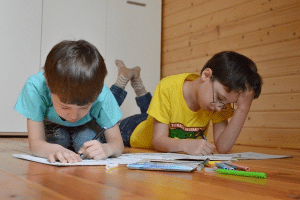It’s not that easy, is it?
It really doesn’t matter whether we’re speaking about you and your job or your children and school, doing it from home can be challenging.
In fact, sometimes it’s downright frustrating and discouraging.
That’s because we usually regard our home as being a place of sanctuary away from the demands of work and school.
 Essentially, it’s a place of ‘freedom’ where we rest and have fun.
Essentially, it’s a place of ‘freedom’ where we rest and have fun.
With so many of us doing so much from home right now, this means things can get a bit blurry.
The key to making it work is to be prepared and to create and manage clearly defined lines of separation between what we usually do at home and working from home.
As we move into Term 2, it’s clear that we’re moving into a period of transition.
It seems most students will continue to experience a mix of home schooling and some level of face to face school contact.
Here’s our essential checklist to help and your children make sure you’re ready for the term ahead.
✔ Do you know what’s required by the school?
Make sure you’re keeping in touch with your school. Most schools will provide learning materials and requirements for the new term.
Be across what these requirements are and how face to face time at school and home schooling will support each other this term.
Also ensure your children know what’s ahead this term by discussing the school’s expectations with them.
It’s a great idea to write goals with them for the term and each week. Doing this can help turn what might look like a huge workload into far more manageable learning chunks.
✔ Have you set up a dedicated learning space?
Create an area in the house for your child to be able to focus on learning. There’s no definitive guide on what this should look like.
Every child has individual ways of learning, so what works for one may not work for another. The good thing about home schooling is that you can set it up to cater for the needs of your child.
As long as the student can focus and be safe, there are no limits to where the learning can take place.
Discuss with your child where they feel best able to learn and allow them to learn in different places, whether lying on the floor or sitting at a table – whatever works best for them.

✔ Do you have the required technology, software, and books?
Check that your computer and WIFI connections are ready to continue supporting a home school programme.
Are headsets working? Is any specific software required this term?
Make sure you have all books and learning materials required. We suggest you also decide where you will store the children’s work and school resources so that everybody knows where they are.
Keeping things neat and organised will help prevent frustration that comes from realising you don’t have what you need, or you don’t know where things are.
Remember to have a basket of treats and rewards. Try not to make these all food based. Sometimes a new shiny pencil or sticker can be far more rewarding to receive for a job well done.
Lastly, stock up with puzzle books, word games, colouring books and easy reading materials to keep children busy when you’re are not available to help them.
✔ Do you have simple systems in place?
Plan a routine and timetable of work and play/rest time. Let your children take part in designing this so they have input in how they will balance their time.
Most schools will also send some kind of structure to parents so best to aim for the time frames provided by the schools, and then be flexible depending on how your child is progressing.
Allow children time to relax between learning periods. There are no hard and fast rules about how many breaks they should have or how long these should be.
Research shows that giving children the freedom to choose how they learn, and how long for, can increase their motivation.
Create a ‘flag’ system for calling for help especially if you have more than one child. This will help prevent everyone demanding and expecting your help constantly and at the same time.
When a child needs your help, they can ‘flag’ you to request help so that both they and you know there’s a practical way for them to get the help they need.
Also set reminders to check in with your children regularly during the day and especially at the end of the day to so see how they are doing.
Keeping communication going is the key to knowing what’s going on and where any potential problems may be brewing.
Encourage children to speak about their feelings as openly as possible to avoid any negativity.
This is also a good time for successes, praise, and rewards to be handled.
✔ Are you and your children mentally prepared?
It’s vital that you and your children are mentally prepared for the new term.
Periods of transition can also be stressful. The longer we have to live life feeling uncertain about the future, the more vulnerable we can become to mental stress.
Take time to develop the right mindset with your children right from the start of the term. Talk openly with them about challenges and their concerns.
Focus on the positive way in which we as a country are dealing with the virus and how you and your family are and can continue to contribute to a positive outcome moving forward.
Discuss self-motivation, especially with older children. Talk about the fact that accepting the situation as it is rather than resisting it actually makes moving forward easier for everybody.
Now would also be a good time to talk about the rules and boundaries you have in place to make home schooling work, and the importance of being considerate and respectful of everybody in the house.
The above list is not exhaustive but an essential checklist to ensure you and your children are prepared to enjoy a successful term together.
Things are changing on a daily and weekly basis so it’s important to stay up to date and flexible so changes can be embraced and implemented with a minimum of fuss. Happy Term 2!
